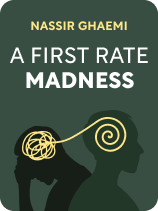

This article is an excerpt from the Shortform book guide to "A First Rate Madness" by Nassir Ghaemi. Shortform has the world's best summaries and analyses of books you should be reading.
Like this article? Sign up for a free trial here.
What’s the difference between mental health and mental illness? Why do so many people confuse the two?
Sometimes, people interchangeably use mental health and mental illness, as if they mean the same thing. While they’re closely related, there’s actually a meaningful difference between the two psychological terms.
Here’s how A First-Rate Madness defines mental health and mental illness so you won’t get confused anymore.
Defining Mental Health and Mental Illness
Nassir Ghaemi offers simple definitions to help you understand the difference between mental health and mental illness:
Mental Health: Ghaemi defines mental health as having no signs of psychological diseases (such as depression) as well as having normal personality traits based on the average population.
Mental Illness: According to Ghaemi, someone who’s mentally ill has both the presence of an illness and abnormal personality traits.
| Other Definitions of Mental Health and Illness While Ghaemi defines mental health as the absence of mental disorders and the presence of normal personality traits, the World Health Organization provides a more elaborate, four-pronged definition: Mental health is a level of psychological wellness that allows us to handle challenges, reach our full potential, perform well, and contribute to our communities. Mental disorders, on the other hand, are significant changes in your thinking, emotional regulation, and behavior that cause distress or hinder your ability to function. Other researchers propose an even broader definition than the WHO and Ghaemi provide, one that they believe is less restrictive or culture-bound: Mental health should be a “dynamic state of internal equilibrium.” In other words, people with good mental health should experience appropriate emotions like fear, sadness, or anger during different times (such as when getting married or mourning the loss of a loved one) but have the resilience to recover from these emotions. |
Ghaemi argues that, beyond mental illness and wellness, there’s a third category to consider. Some people have abnormal personalities or temperaments, meaning they’re neither ill nor completely healthy. This third category can exist because mental health lies on a spectrum—there’s no definite line dividing mental wellness and mental disorder.
Ghaemi explains that personalities generally form around the age of three and remain relatively unchanged throughout adulthood. People with abnormal personalities have natural traits similar to symptoms of mental illnesses, but those traits are milder and longer-lasting. For example, someone might naturally be more melancholic and have lower energy compared to the average population but not be depressed.
(Shortorm note: By “abnormal personality,” Ghaemi is mainly referring to dysthymia, hyperthymia, and cyclothymia—the first resulting in mild melancholy, the second in mild mania, and the last in mild mood swings. However, other psychologists would categorize these as mood disorders, which distort your emotional state. When talking about “abnormal personalities,” other psychologists may be referring to personality disorders, which are dysfunctional thought and behavior patterns, such as antisocial or schizoid personality disorder. This disagreement over the definition of “abnormal personality” reinforces the idea that mental health exists on a spectrum and that conditions can’t be objectively categorized.)
Unlike for physical diseases, there aren’t any tests that can definitively diagnose mental illness. To make his diagnoses of deceased historical figures, Ghaemi researched for evidence of symptoms, how long the symptoms lasted, family history, and treatment history.
(Shortform note: For each historical figure, Ghaemi is making a retrospective diagnosis—a diagnosis based solely on historical documents. Researchers point out the challenges of making such diagnoses, arguing that a retrospective diagnosis forgoes the typical physician-patient relationship that allows for first-hand observation and is often considered vital to making any type of clinical diagnosis. Furthermore, critics argue that diseases change over time and that documents alone can’t accurately reflect someone’s lived experience. For this reason, they encourage interdisciplinary collaboration between medical specialists and historians for retrospective diagnosis.)

———End of Preview———
Like what you just read? Read the rest of the world's best book summary and analysis of Nassir Ghaemi's "A First Rate Madness" at Shortform.
Here's what you'll find in our full A First Rate Madness summary:
- How mental illness can make someone a better leader
- How leaders like Churchill and Roosevelt benefited from mental illness
- The pitfalls of being a mentally well leader during a time of crisis






